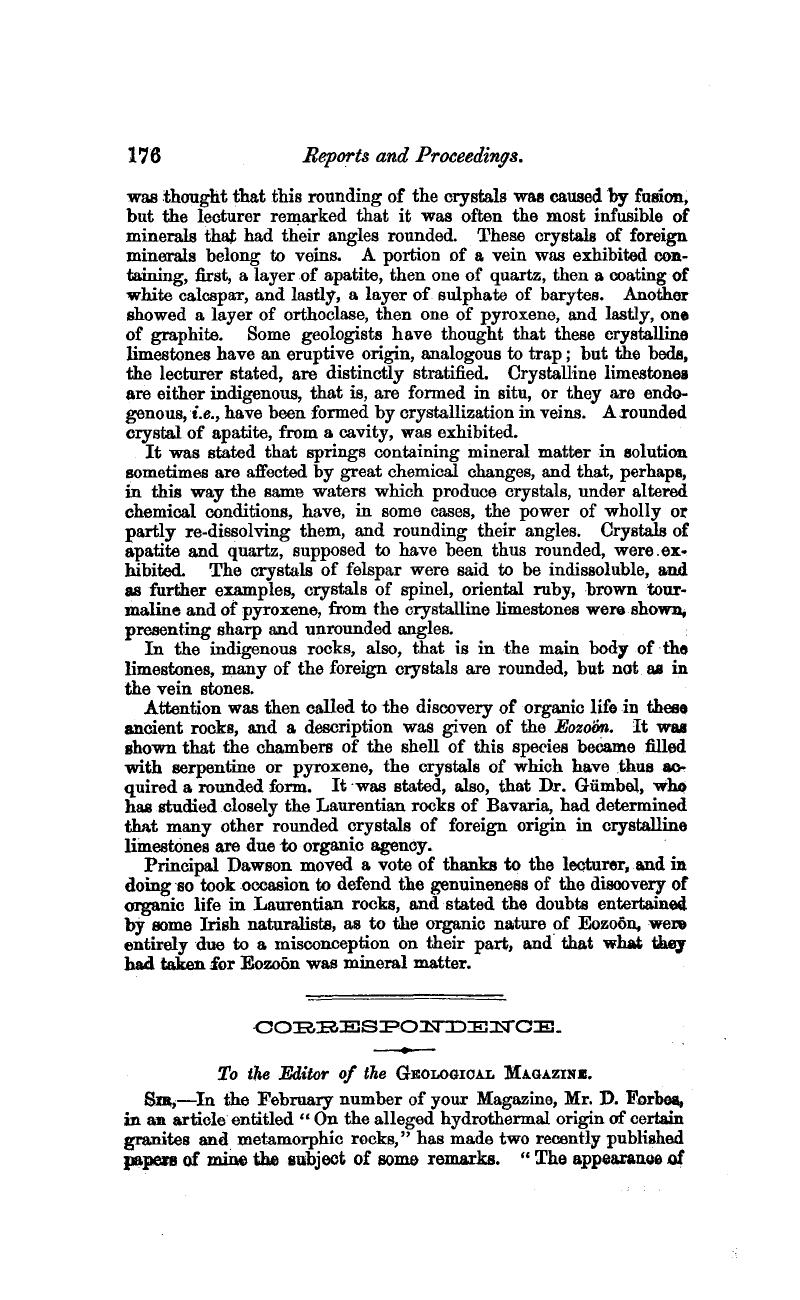Article contents
To the Editor of the Geological Magazine
Published online by Cambridge University Press: 01 May 2009
Abstract

- Type
- Correspondence
- Information
- Copyright
- Copyright © Cambridge University Press 1867
References
page 178 note 1 Some interesting remarks on the value of chemical analyses of rocks will be found in Cotta's “Rocks classified and described” (1866) p. 79.
page 178 note 2 Similar opinions, based upon long-continued study of the chemistry of tha subject, have been placed “before a rational public,” by, among others, Delesse, ana Sterry Hunt.
page 179 note 1 Cotta includes hyperite, diorite, diallage-rock, and some other allied rocks in his Greenstone group.
page 179 note 2 The term augitic greenstone is not, however, confined to the pages of writers on Scottish, geology; Cotta has the same expression. [See “Rocks classified and described,” p. 146.] He describes the “greenstones” as “compounds of some species of felspar with pyroxene, or hornblende, as essential ingrediets, etc:” among the species of greenstone augile-porphyry is mentioned. In Professor Phillips'a “ Manual” we find mention made of augitie greenstone (augite and felspar) as distinguished from greenstone (hornblende and felspar); and Sir C. Lyell, while be defines greenstone to be a compound of felspar and hornblende, yet takes care to state that “the name has usually been extended to all granular mixtures, whether of hornblende and felspar, or of angite and felspar.” (Elements of Geol., p. 594).
page 179 note 3 J'emploie le terme de grünstein pour lea roches trappéenes cristallisées verdâtres, que je n'ai pas examinées, et qui ont été décrites sous ce nan, et pour celles quo j'ai bien obserrvéees en place, mais dont je n'ai conservé aucun éebantillon pour pouvoir constfltej à présent si ce sent des dó1érites ou des diabases.” Boué Essai Géologique ![]() , 182Q, p. 135.
, 182Q, p. 135.
page 180 note 1 No one has of late years done more towards the explanation of metamorphic phenomena than the well-known chemist and mineralogist attached to the Geological Surrey of Canada. Dr. Sterry Hunt is of opinion “that heated alkaline waters have produced the alteration of sediments,” and “ that, except in local and comparatively, rare cases, the process has only taken place in sediments so deeply buried as to be directly affected by the internal heat of the earth.” Whether we agree with him or not in his conclusions as to the eauses of metamorphism, those among us who may still cling to the notion that all crystalline rocks which cannot be classed among the gneisses and schists must be of igneous origin, will do well to study the details furnished in the “Reports” of the Canadian Surrey. We there find rocks described as metamorphic which at one time would certainly have been coloured upon a geological map as igneous; for they frequently present appearances (as, for instance, an amygdaloidal structure) which are commonly believed to be characteristic of igneous' rocks only. See Geology of Canada (1863), pp. 603, 607.
page 180 note 2 Rocks Classified and Described, p. 388.
page 180 note 3 It is instructive to find this eminent chemist thus endeavouring to “prove” the formation in the wet way of certain crystalline rocks which geologists on the other hand are frequently (not always) well assured must be of igneous and eruptive origin.
page 181 note 1 See his memoir in the first numher of the “Nyt Magazin for Naturvidenskaberne,” a translation of which (with notes by Professor Jameson) will be found in the “Edinburgh Philosophical Magazine,” Vol. xxiv., p. 387.
page 181 note 2 Geology of Canada, p. 586. The Canadian geologists also describe certain granites, which they consider to be eruptive, designating them as intrusive granites, in contradistinction to those having a metamorphic origin, which are termed indigenous granites.
page 181 note 3 Geology of North, Wales Mem. of Geol. Survey, vol.iii., pp. 140 et seq; 190 et seq. After describing certain phenomena exhibited in the neighbourhood of the quartz-porphyry, Professor Ramsay remarks that he can only account for these appearances by the supposition that the beds associated with the quartz-porphyry have, as it were, been partly eaten into by heat, and themselves converted into porphyry. He comes to similar conclusions in regard to the granite of Anglesey.Google Scholar
page 181 note 4 Manual of Geology, p. 74, et seq.Google Scholar
page 181 note 5 My critic represents me as refusing any longer to accept the definition of eruptive or intrusive rocks which geologists have been accustomed to give, viz., that they “are such rocks as are met with apparently breaking through, protruding into, or sending out ramifications, dykes, or veins, into the adjacent stratified deposits.” Now all that can be inferred from what I have said is, that some of these appearances are simulated by metamorphic rocks, and in this I believe “ most geologists will concur with” me.
page 182 note 1 I am well aware that some geologists are folly petsuadtd of the igneous and èruptive character of certain gneissic rock.
- 1
- Cited by


